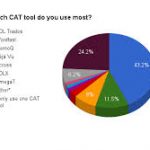The café in Paris, France opened its doors for the pedestrians that might pass and venture in. In the window, paintings were being exhibited from the new impressionist vogue sweeping the nation. Around the same time in Germany and the United States, engineers were building the first automobiles simultaneously as if the invention was a product of the time period and not one man. And then a century later, a similar phenomenon occurred: tools to ease the work of translators called translation memory (TM) began being developed in the countries aforementioned by several companies at the same time. The computer age concretized what the language industry had imagined for years to be machine-assisted human translation (MAHT) and by the 1990s, computer-assisted translation (CAT) was on the market offering to manage translation memories. While software like SDL Trados and Déjà Vu gained traction early on, WordFast and MemoQ also have a large stake in the TM industry.
In the 1980s, Stuttgart, Germany saw the first steps of the Trados company, short for Translation Documentation Software, which were giant leaps. While at first, contracts were negotiated with IBM and other companies to provide language services, influence from new European terminology banks and sentence alignment technology (a tool to retrieve formerly translated sentences) saw the company look towards computers to assist their workflow. Already in 1988, a tool dubbed TED was created, the precursor to Translator Workbrench and Multiterm which would run TM from computers. The name TM itself, is reportedly a Trados creation while the structure was loosely based on the Translation Support System (TSS) developed by ALPS which used a word processor, a terminology manager, and sentence segment alignment. IF TSS would not last very long on the market, Trados was able to sell 200 licenses to the European commission four years later, in 1992. From there, the trademark successfully made the transition to a Windows operating system to become the de facto standard for CAT tools; compatibility with Trados files now considered a prerequisite in the language industry, whether for large corporations or freelancers. The actual program is said to have been purchased by several thousand firms worldwide and over two thirds of the market share. The new updates target localization and content management which may see the company rise to still unprecedented levels.
Also in the 1990s, larger LSPs were still developing similar software in-house and one outside company, Déjà Vu, arose as a competitor to Trados, especially in the freelance sector. The previously mentioned Trados packages, including Workbench, Multiterm and the alignment tool called WinAlign, were separate components which Déjà Vu capitalized on by offering one easy and comprehensive package. Based in Paris, Déjà Vu’s capabilities vary more with the Parisian firm WordFast, which was first marketed in 2002, than with Trados. Déjà Vu adopted its own graphical user interface in 1996 while WordFast remains an add-on in Microsoft Word. The former can also manage open documents which WordFast cannot do, though both, along with Trados easily manage Word, Java, HTML, XLIFF, TMX and many Desktop Publishing program files. SDL Trados Studio versions add supportability for a plethora of older Trados bilingual files and a new Studio translation memory format (SDLTM). This is the future of TM with post-editing incorporated and Machine Translation (MT) used to fill some of the gaps!
The advantage of WordFast is the lower price tag which comes from its years as freeware. In fact, over a million translation units and 100,000 glossary units can be stored on their current freeware. Meanwhile, MemoQ is also a unique product because of how closely integrated TM is to the project management and work flow that is the basis of the program. The non-proprietary file type, Translation Memory eXchange (TMX) is also a major component of MemoQ . In fact, TMX can no longer be ignored by any translation memory company due to the approaches it offers for reuse of text at the phrase level instead of the sentence level.
Finally, the different programs have different applications for shared translation memory over networks of translators. The Studio version of SDL Trados offers the possibility to work over a network as does the VLTM (very large translation memory) functionality on WordFast. While the other companies have their own versions for networking, Déjà Vu is on the forefront something else, phrase level technology. Their auto-assemble tools employ a new concept, example-based machine translation. All in all, there are plenty of paths that TM and CAT tools can take, now that these acronyms have been explained, with the only limit being the impossibility of completing a translation without the human component. The rise of software development is remindful of other phenomena in history, when similar tools were being developed in different areas of the world. The goal of these particular tools are none other than uniting this large and globalized world even more.
For an overview of our translation expertise, visit our software translation and localization page




